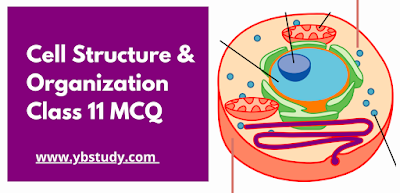Cell Structure and Organization MCQ for Class 11 Pdf Maharashtra Board
Cell Structure and Organization MCQ for NEET:
How small do you imagine an organism can be? Before the invention of the microscope, the answer to this question was a well-kept secret. Today we know that the cell is the smallest unit of life that can feed, breathe, reproduce, etc. For this reason, the cell is characterized as the basic structural and functional unit of life.
Just as a building is made up of many bricks, a plant or animal is made up of many tiny cells. This is why organisms such as plants and animals are called multicellular. But there are also single-celled organisms called Prokaryotes, such as the amoeba, that consist of a single cell. These organisms are visible only with the help of a microscope.
Here below we have provided MCQ Questions for Class 11 on Cell Structure and Organization with Answers Pdf free download. MCQ Questions for Class 11 Cell Structure and Organization with Answers were prepared based on the latest exam pattern of the Maharashtra state board. Class 11 Cell Structure and Organization MCQs Questions with Answers to help students understand the concept very well and also read Cell Structure and Organization textbook solutions for Class 11.
MCQ on Cell Structure and Organization for Class 11:
A. Growth of cell wall during cell elongation takes place by___________
a. Apposition
b. Intussusception
c. Both a & b
d. Superposition
B. Cell Membrane is composed of_____________
a. Proteins and cellulose
b. Proteins and Phospholipid
c. Proteins and carbohydrates
d. Proteins, Phospholipids,s, and some
carbohydrates
C. Plasma membrane is Fluid-structure due to presence of_____________
a. Carbohydrates
b. Lipid
c. Glycoprotein
d. Polysaccharide
a. Plant cell
b. Prokaryotic cell
c. Algal cell
d. All of the above
E. Plasma membrane is_______________
a. Selectively permeable
b. Permeable
c. Impermeable
d. Semipermeable
F. Mitochondria DNA is______________
a. Naked
b. Circular
c. Double stranded
d. All of the above
G. Lysosomes are not help full in______________
a. Osteogenesis
b. Cellular digestion
c. Metamorphosis
d. Lipogenesis
H. Which of the following set of organelles contain DNA_______________
a. Mitochondria, Peroxisome
b. Plasma membrane, ribosome
c. Mitochondria, chloroplast
d. Chloroplast, dictyosome
I. Golgi body is absent in______________
a. Prokaryotes
b. Mature mammalian RBC
c. Eukaryotes
d. All of the above

